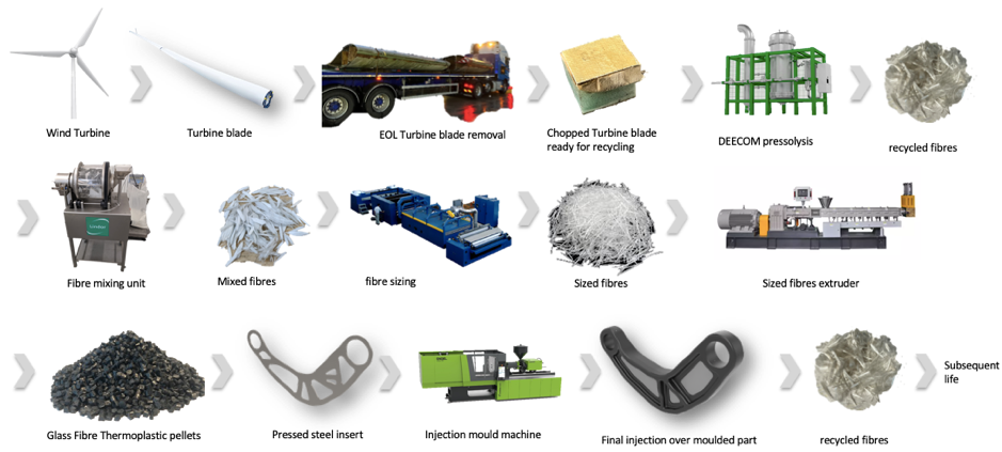Category: Wild Card
Headline Sponsor: Igus
Project: EMPHASIZING
Partners: B&M Longworth with Gestamp UK, Ford UK, Gen 2 Plank Ltd, TWI, Brunel University London and EMS Grivory
This year’s C2I Wild Card winner is a shining example of the circular economy in action and a benchmark for what can be achieved through cross-sector, multi-disciplinary collaboration.
Led by B&M Longworth, EMPHASIZING has applied a novel method for recycling glass fibre reinforced plastic (GRP) from a variety of waste streams, producing a composite material that improves on the properties of virgin GRP. To demonstrate the innovation, the EMPHASIZING partners used the recyclate material to manufacture a lightweight Ford automotive product from decommissioned wind turbine blade GRP.
Currently, 2.5 million tonnes of composite material are used globally in the renewable energy sector, with an estimated 12-15 tonnes of GRP required for every MW of new wind power. While the benefits of wind energy are unquestionable, there have been increasing concerns over the future disposal of GRP as wind farms reach end of life (EOL). According to EMPHASIZING, the sector is expected to decommission 40,000 to 60,000 tonnes of composite materials in the next two years, and finding a circular solution for the GRP conundrum is essential.
“The EMPHASIZING consortium’s key passion is about representing the entire supply chain, from reclaimable materials right through to proven reuse case, at scale,” said Jen Hill, director at B&M Longworth.
“The strength in our partnership is largely based on each partner organisation having a clear agenda for the successful outcome of the project; no partner is ‘along for the ride’ and all agreed during the bid phase that the subject of sustainable composites needed ‘less talk, more action’.”
At the core of the EMPHASIZING project is DEECOM pressolysis, a pressure-based material reclamation technique described as a ‘technical step change’ from established processes such as pyrolysis and solvolysis. DEECOM uses steam and pressure to de-bond resin and polymeric contaminants from fibre. According to B&M Longworth, the method is proven to yield pristine quality fibre without suffering any performance degradation, allowing reclaimed glass fibre to be reprocessed and value to be added in terms of strength, weight, CO2e and ultimately commercial viability.
Another key stage – and one from which the project derives its name – is the sizing process. Once the fibre has been reclaimed using DEECOM pressolysis, it is then chopped and resized to make it suitable for compounding. This stage of the project involved reclaimed fibre being chopped and resized in standard benchmark bay-bond sizing by Gen2Plank. This material was then assessed by EMS Grivory as ‘suitable for compounding’.
To demonstrate the material’s capabilities, it was used in the manufacture of a Ford camber-link component, which is currently steel-manufactured by Gestamp. This component was chosen as being a good representation of how the EMPHASIZING technology could deliver material for a range of other structural Ford products.
The camber-link also had the added impact of being part of the vehicle’s un-sprung mass, helping to lower overall weight and reduce the work the shocks and springs have to do to keep the tires in contact with the road over bumpy surfaces. The partners believe the demonstrator could provide a benchmark for the performance of thermoplastic composite hybrid parts compared to steel fabrication in structural mass production.

According to Composites UK’s Vision and Roadmap, sustainable composites will become a ‘go to’ material for the mobility sector by 2040. This includes a transition through another generation of vehicles around the end of this decade where composite use has increased to replace some metallic parts, followed by the 2040 generation where composite materials are likely to be widespread. It is expected that demand for advanced materials such as carbon fibre will outstrip supply as early as 2025, meaning new materials streams will need to be found.
“Our technology partners have proven processes for reclaiming and reprocessing of end of life materials, with an appetite to scale up and commercialise,” said Hill. “Meanwhile, EMPHASIZING’s manufacturing partners represent the need for a shift in our automotive industry supply chain’s use of composites in order to hit light-weighting, net zero and LCA targets, as well as the challenge of the EOL vehicle directive for 95 per cent recyclable vehicles.
“With all of these factors in mind, all partners are equally focused on success of the project and the exploitation and dissemination activities are as strong as we’ve seen in much larger and better-funded projects.”
With the global composites market currently at £50 billion – and projected to grow considerably in the coming years – EMPHASISZING presents a significant economic opportunity as well as a sustainable, circular solution for the rapidly expanding GRP waste stream. The displacement of virgin glass and carbon fibre production makes composites truly circular on a mass global scale, helping to meet the global shortfall in supply expected by 2025.
The wind and marine sectors will benefit from a reclassification of EOL wind blades and marine vessels, transforming them from hazardous waste to a material feedstock. Alongside opening up new revenue streams, this could also potentially help avoid legal implications and costly levies, while at the same time diverting composite waste from landfill. The end result of EMPHASIZING is a brand new, characterised advanced material with impressive performance mechanics, low embedded carbon, abundant in supply, that can be used globally across multiple industries.











IET sounds warning on AI doll trend
I agree that we need to reduce cooling water demand for servers. And yes, generative AI consumes a large amount. But what about BitCoins? Their...